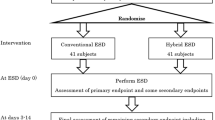Abstract
Background
Endoscopic submucosal dissection (ESD) can be technically demanding and requires great attention to detail and prolonged concentration. We assumed that clinical outcomes of ESDs may be affected by cumulative time, and we aimed to compare complete resection rates and adverse events according to cumulative ESD time.
Methods
This study involved 1,328 consecutive patients with 1,461 gastric tumors who underwent ESD from January 2008 to July 2011 in a tertiary-care academic medical center. The main outcome measurements were en bloc resection rate, complete resection rate, bleeding rate and perforation rate.
Results
Patients were divided into three groups according to cumulative time intervals (<2 h vs. 2–4 h vs. ≥4 h). Complete resection rate did not differ among the three groups, but early post-ESD bleeding (EPEB) rate was significantly different among the three groups (2.5 vs. 3.5 % vs. 6.6 %, P = 0.040). In multivariate analysis, cumulative time period was an independent predictor of EPEB (2–4 h odds ratio [OR] 2.29, 95 % confidence interval [CI] 1.05–5.01, P = 0.038; ≥4 h OR 3.99; 95 % CI, 2.15–7.65, P < 0.001). The rate of perforation was higher in ESDs performed after completing prior endoscopies or outpatient clinic session compared to those performed without prior work (3.8 vs. 1.6 %, P = 0.004). Moreover, prior workload before ESD was an independent predictor of perforation in multivariate analysis (OR 2.77, 95 % CI, 1.37–5.60, P = 0.005).
Conclusions
Our data suggest that cumulative ESD time did not influence en bloc or complete resection rate of ESD, but increased the rate of acute bleeding. Moreover, prior workload before ESDs may increase the risk of perforation.
Similar content being viewed by others
References
Shimuzu S, Tada M, Kawai K (1995) Early gastric cancer: its surveillance and natural course. Endoscopy 27:27–31
Ikeda Y, Mori M, Koyanagi N, Wada H, Hayashi H, Tsugawa K, Miyazaki M, Haraguchi Y, Sugimachi K (1998) Features of early gastric cancer detected by modern diagnostic technique. J Clin Gastroenterol 27:60–62
Fujishiro M (2006) Endoscopic submucosal dissection for stomach neoplasm. World J Gastroenterol 12:5012–5108
Yahagi N, Fujishiro M, Kakushima N (2004) Endoscopic submucosal dissection for early gastric cancer using the tip of an electro-sergical snare (thin type). Dig Endosc 16:34–38
Oda I, Gotoda T, Hamanaka H (2005) Endoscopic submucosal dissection for early gastric cancer: technical feasibility, operation time and complications from a large consecutive series. Dig Endosc 17:54–58
Oka S, Tanaka S, Kaneko I, Mouri R, Hirata M, Kawamura T, Yoshihara M, Chayama K (2006) Advantage of endoscopic submucosal dissection compared with EMR for early gastric cancer. Gastrointest Endosc 64:877–883
Sanaka MR, Deepinder F, Thota PN, Lopez R, Burke CA (2009) Adenomas are detected more often in morning than in afternoon colonoscopy. Am J Gastroenterol 104:1659–1664
Sanaka MR, Shah N, Mullen K, Ferguson DR, Thomas C, McCullough AJ (2006) Afternoon colonoscopies have higher failure rates than morning colonoscopies. Am J Gastroenterol 101:2726–2730
Chan MY, Cohen H, Spiegel BMR (2009) Fewer polyps detected by colonoscopy as the day progresses at a Veterans Administration teaching hospital. Clin Gastroenterol Hepatol 7:1217–1223
Schlemper RJ, Riddell RH, Kato Y (2000) The Vienna classification of gastrointestinal epithelial neoplasia. Gut 47:251–255
Gaba DM, Howard SK (2002) Patient safety: fatigue among clinicians and the safety of patients. N Engl J Med 347:1249–1255
Gaba DM, Howard SK, Jump B (1994) Production pressure in the work environment: California anesthesiologists’ attributes and experiences. Anesthesiology 81:488–500
Mehta PP, Sanaka MR, Parsi MA, Zuccaro G, Dumot JA, Lopez R, Vargo JJ (2011) Effect of time of day on the success and adverse events of ERCP. Gastrointest Endosc 74:303–308
Takizawa K, Oda I, Gotoda T, Yokoi C, Matsuda T, Saito Y, Saito D, Ono H (2008) Routine coagulation of visible vessels may prevent delayed bleeding after endoscopic submucosal dissection—an analysis of risk factors. Endoscopy 40:179–183
Owens JA (2001) Sleep loss and fatigue in medical training. Curr Opin Pulm Med 7:411–418
Weinger MB, Ancoli-Israel S (2002) Sleep deprivation and clinical performance. JAMA 287:955–957
Dawson D, Reid K (1997) Fatigue, alcohol and performance impairment. Nature 388:235
Gerdes J, Kahol K, Smith M, Leyba MJ, Ferrara JJ (2008) Jack Barney award: the effect of fatigue on cognitive and psychomotor skills of trauma residents and attending surgeons. Am J Surg 196:813–820
Higashiyama M, Oka S, Tanaka S, Sanomura Y, Imagawa H, Shishido T, Yoshida S, Chayama K (2011) Risk factors for bleeding after endoscopic submucosal dissection of gastric epithelial neoplasm. Dig Endosc 23:290–295
Sugimoto T, Okamoto M, Mitsuno Y, Kondo S, Oqura K, Ohmae T, Mizuno H, Yoshida S, Isomura Y, Yamaji Y, Kawabe T, Omata M, Koike K (2012) Endoscopic submucosal dissection is an effective and safe therapy for early gastric neoplasms: a multicenter feasible study. J Clin Gastroenterol 46:124–129
Chung IK, Lee JH, Lee SH, Kim SJ, Cho JY, Cho WY, Hwangbo Y, Keum BR, Park JJ, Chun HJ, Kim HJ, Kim JJ, Ji SR, Seoul SY (2009) Therapeutic outcomes in 1000 cases of endoscopic submucosal dissection for early gastric neoplasms: Korean ESD Study Group multicenter study. Gastrointest Endosc 69:1228–1235
Yoo JH, Shin SJ, Lee KM, Choi JM, Wi JO, Kim DH, Lim SG, Hwang JC, Cheong JY, Yoo BM, Lee KJ, Kim JH, Cho SW (2012) Risk factors for perforations associated with endoscopic submucosal dissection in gastric lesions: emphasis on perforation type. Surg Endosc 26:2456–2464
Disclosures
Drs. S. M. Lim, J. C. Park, H. Lee, S. K. Shin, S. K. Lee, and Y. C. Lee have no conflicts of interest or financial ties to disclose.
Author information
Authors and Affiliations
Corresponding author
Rights and permissions
About this article
Cite this article
Lim, S.M., Park, J.C., Lee, H. et al. Impact of cumulative time on the clinical outcomes of endoscopic submucosal dissection in gastric neoplasm. Surg Endosc 27, 1397–1403 (2013). https://doi.org/10.1007/s00464-012-2643-3
Received:
Accepted:
Published:
Issue Date:
DOI: https://doi.org/10.1007/s00464-012-2643-3




